Immediate Post-Surgery Care
After surgery, keep the gauze pad in place for 30 minutes to control bleeding. Apply gentle pressure and use cool packs on your cheeks and jaws to reduce swelling. Avoid using straws, spitting, or sucking on the surgery day; straws are okay afterward if bleeding stops.
1.1 Managing Bleeding
Bleeding after dental implant surgery is normal and may continue for several hours. To manage it, keep the gauze pad in place for 30 minutes, then gently bite on a clean gauze or damp tea bag if needed. Stay upright and avoid spitting, rinsing, or sucking, as this can dislodge the clot. Apply cool packs to your cheeks to reduce swelling and bleeding. If bleeding increases, contact your dentist immediately. Avoid hot foods, liquids, or strenuous activities that could worsen bleeding. Monitor the color and consistency; if it doesn’t improve or stops entirely, seek medical advice to prevent complications.
1.2 Using Ice Packs
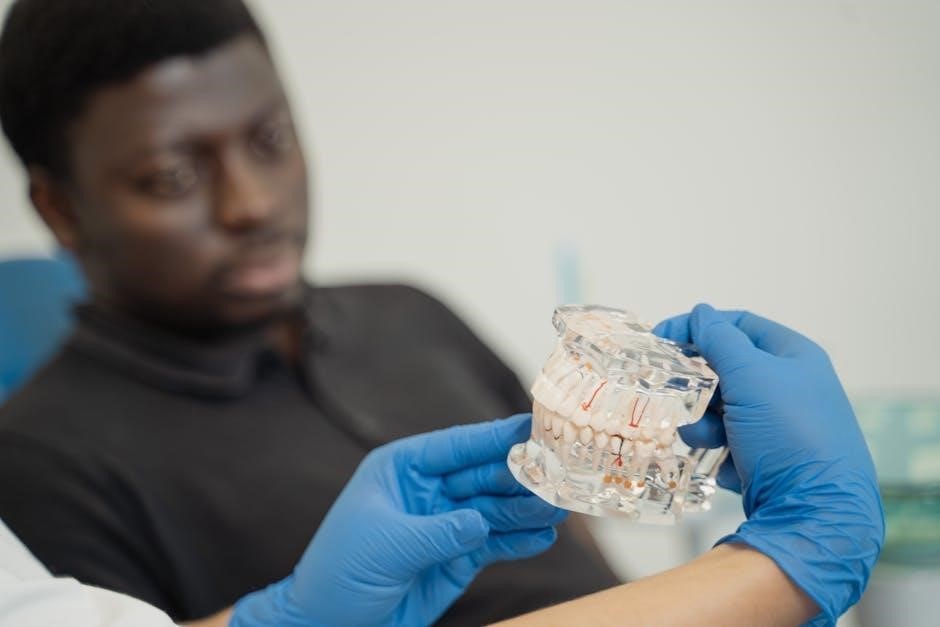
Apply ice packs to your cheeks, jaws, and chin immediately after surgery to reduce swelling and discomfort. Wrap the ice packs in a cloth to avoid direct skin contact. Use them for 20 minutes on and 20 minutes off during the first 24 hours. Gently press the ice packs against the areas to maximize effectiveness. This helps minimize bruising and inflammation, promoting faster healing. Continue as needed, but avoid prolonged use that could cause skin irritation. Ice therapy is most beneficial in the initial post-operative period, ensuring a smoother recovery process for dental implant patients.
1.3 Avoiding Straws, Spitting, or Sucking
Avoid using straws, spitting, or sucking on anything immediately after surgery, as these actions can dislodge the blood clot and interfere with healing. On the day of surgery, refrain from such activities entirely. Straw use is permitted after the initial healing period if bleeding has stopped. Sucking or spitting can create negative pressure in the mouth, which may disrupt the implant site. Instead, drink liquids gently and avoid activities that involve suction, such as smoking or blowing. This precaution helps ensure proper clot formation and supports the healing process for the best outcomes.
Dietary Recommendations
Start with a soft, balanced diet, avoiding hard, crunchy, or chewy foods. Gradually introduce soft foods after 4 weeks, ensuring proper nutrition for healing.
2.1 Initial Soft Food Diet
Begin with a soft, mild, and nutritionally balanced diet immediately after surgery. Opt for foods like yogurt, scrambled eggs, and mashed potatoes to minimize chewing. Avoid hard, crunchy, or chewy foods to protect the surgical site. Stay hydrated with lukewarm soups or smoothies, but avoid using straws initially. Ensure meals are easy to swallow and require minimal effort. This initial phase helps promote healing and reduces discomfort. Aim for a diet rich in proteins and vitamins to support recovery. Avoid extremely hot or cold foods and drinks for the first few days to prevent irritation.

2.2 Transitioning to Soft Foods After 4 Weeks
After 4 weeks, you can gradually introduce soft foods like soft-cooked vegetables, soft meats, and pasta. Avoid chewing directly on the implant site. Continue to steer clear of hard, crunchy, or chewy foods for the entire healing period, typically 8 weeks. Soft foods help minimize stress on the implants while allowing for some variety in your diet. Ensure foods are still easy to chew and swallow to avoid discomfort or complications. This phase supports continued healing while gradually reintroducing more texture to your meals. Stick to soft foods until your dentist confirms it’s safe to progress further.
2.3 Avoiding Hard, Crunchy, or Chewy Foods
For the entire healing period, typically 8 weeks, it’s crucial to avoid hard, crunchy, or chewy foods like nuts, raw vegetables, and hard candies. These can dislodge the implant or cause discomfort. Stick to soft, mild foods that don’t require heavy chewing. This precaution protects the implant and allows the bone to heal properly. By avoiding such foods, you minimize the risk of complications and ensure proper integration of the implant. This dietary restriction is essential during the initial healing phase to support the success of your dental implant procedure.

Oral Hygiene Practices
Rinse gently with warm water, avoid spitting, and use chlorhexidine as directed. Start brushing with gentle products 2 weeks post-surgery to promote healing and prevent infection.

3.1 Rinsing and Avoiding Spit
Avoid rinsing or spitting for 24 hours after surgery to prevent dislodging the blood clot. After 24 hours, rinse gently with warm water to keep the area clean. Refrain from using harsh mouthwashes initially. Instead, consider saline solution or chlorhexidine (Peridex) as directed by your dentist. Keep your tongue and fingers away from the surgical site to avoid irritation. Proper rinsing helps prevent infection and promotes healing. Start using chlorhexidine 2 weeks post-surgery for long-term care. Gentle oral hygiene practices are essential for the success of your dental implant.
3.2 Brushing with Gentle Products
Begin brushing gently 24 hours after surgery, using a soft-bristled toothbrush and mild toothpaste. Avoid harsh or abrasive products that could irritate the surgical site. Focus on cleaning teeth and gums without disturbing the implant area. For the first two weeks, use chlorhexidine (Peridex) as directed by your dentist for its antimicrobial properties. Gently brush in small circular motions, keeping the brush away from the surgical site. Proper brushing helps maintain oral hygiene and supports healing. Use gentle products to avoid discomfort and promote a smooth recovery. This practice is crucial for the success of your dental implant and overall oral health.
3.4 Using Chlorhexidine (Peridex)
Chlorhexidine, commonly known as Peridex, is an antimicrobial mouthwash used to promote healing and prevent infection after dental implant surgery. Start using it 2 weeks post-surgery as directed by your dentist. Dip a cotton swab in the solution and gently apply it to the surgical site, avoiding direct contact with the implant. Do not rinse or spit excessively, as this could dislodge the dressing. Peridex helps reduce bacteria and inflammation, supporting the healing process. Follow the recommended usage to ensure proper integration of the implant and maintain oral hygiene. Proper application is key to achieving optimal results and minimizing complications during recovery.
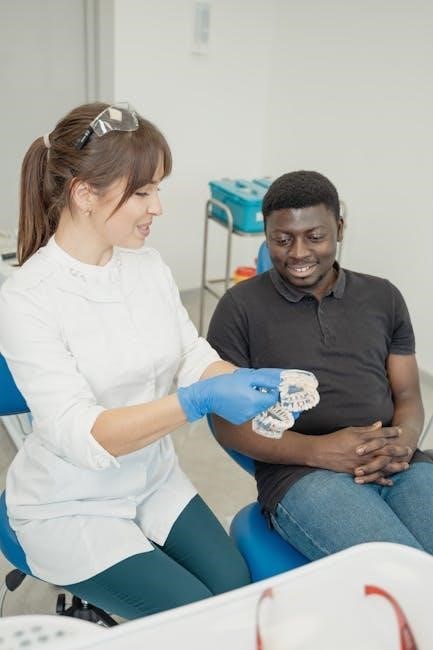
Activity Restrictions
Rest is crucial after surgery. Avoid strenuous activities to prevent dislodging the blood clot and ensure proper healing. Limit physical exertion for the first few days.
4.1 Rest and Avoiding Strenuous Activities
Rest is essential after dental implant surgery to promote healing. Strenuous activities can dislodge the blood clot, risking implant failure. Avoid heavy lifting, bending, or exercise for 48-72 hours. Even after initial recovery, intense workouts should be avoided for 1-2 weeks. Light activities like walking are acceptable but should not cause strain. Proper rest ensures the implant integrates well with the jawbone. Overexertion can lead to complications, delaying recovery. Prioritize comfort and recovery to achieve optimal results for your dental implant.
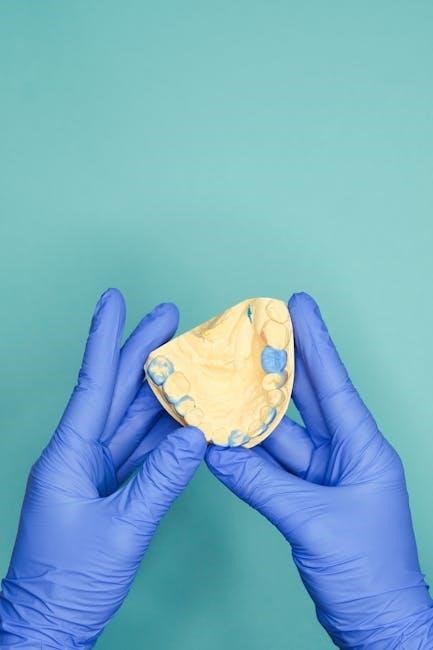
Follow-Up Care
Attend scheduled check-ups to monitor healing and implant integration; Follow your dentist’s instructions for post-operative care to ensure proper recovery and optimal results.
5.1 Scheduled Check-Ups
Regular follow-up appointments are crucial for monitoring the healing process and ensuring proper implant integration. Your dentist will assess the surgical site, check for any signs of complications, and confirm that the bone is healing as expected. These check-ups typically occur at intervals of 1-2 weeks, 4 weeks, and then periodically over several months. During these visits, your dentist may also evaluate the soft tissue healing and prepare for the next stages of treatment, such as abutment placement or crown fitting. Adhering to the recommended schedule ensures optimal recovery and long-term success of your dental implant.
5.2 Suture Removal
Sutures are typically removed 7-10 days after surgery, depending on the healing progress. Dissolvable sutures may not require removal, as they break down naturally. During the removal process, your dentist will examine the healing of the surgical site and ensure there are no signs of complications. It’s important to avoid touching or disturbing the sutures before removal, as this can interfere with healing. Follow all post-operative instructions carefully to promote proper recovery. Attending scheduled suture removal appointments is crucial for ensuring the implant site heals correctly and maintains its integrity for long-term success.
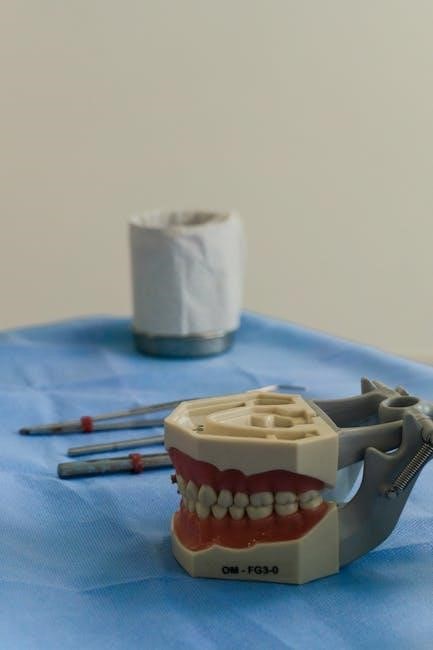
Potential Complications
Prolonged bleeding, swelling, or infection can occur. Monitor for signs of infection, such as redness or increased pain. Follow post-op instructions to minimize these risks.
6.1 Prolonged Bleeding
Bleeding after implant surgery is normal but should subside within a few hours. Apply gentle, firm pressure with gauze for 30 minutes if bleeding persists. Elevate your head while resting to reduce blood flow to the surgical site. Avoid strenuous activities, as they can dislodge clots and restart bleeding. If bleeding continues beyond 24 hours or becomes heavy, contact your dentist immediately. Excessive bleeding may indicate complications requiring medical attention. Monitor the color and consistency of the discharge to assess if it’s within normal expectations. Following post-operative care instructions carefully can help minimize the risk of prolonged bleeding.
6.2 Swelling and Infection
Swelling is a common reaction to surgery and typically subsides within 2-3 days. Use ice packs on the affected area to minimize swelling. Infection risk is low but can occur if post-op instructions aren’t followed. Signs of infection include increased redness, swelling, warmth, or pus around the surgical site, along with fever or chills. Keep the area clean by rinsing with saltwater or prescribed mouthwash. If symptoms persist or worsen, contact your dentist immediately. Infections may require antibiotics or additional treatment. Monitor healing progress and report any unusual changes to ensure proper recovery and prevent complications.
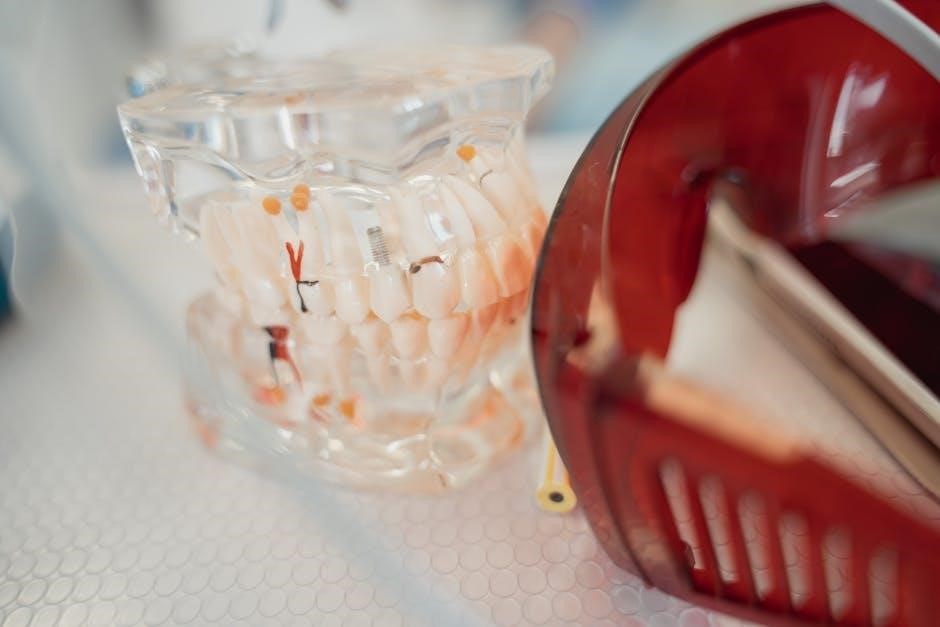
Long-Term Healing and Care
Long-term healing involves monitoring implant integration and maintaining oral hygiene. Regular check-ups ensure proper healing and functionality. Avoid smoking and excessive force on implants for optimal results.
7.1 Bone Healing Process (3-6 Months)
Bone healing around the implant typically takes 3-6 months. During this period, the jawbone integrates with the implant, ensuring stability. A soft diet is crucial to avoid disrupting the healing process. Avoid hard, crunchy, or chewy foods until the bone is fully healed. Regular follow-ups with your dentist are essential to monitor progress and ensure proper integration. Maintaining good oral hygiene and avoiding smoking or excessive force on the implant supports long-term success. This phase is critical for the implant to function like a natural tooth.
7.2 Monitoring Implant Integration
Regular follow-ups are crucial to monitor implant integration. Your dentist will use X-rays to assess bone healing and ensure the implant is stable. Proper integration ensures the implant functions like a natural tooth. Avoid smoking and excessive force on the implant during healing. A soft diet is recommended until integration is complete. Attend all scheduled check-ups to ensure optimal results and address any concerns promptly.
7.3 Maintaining Oral Hygiene
Maintaining proper oral hygiene is vital for implant success. Gently brush the implant site with a soft toothbrush and mild toothpaste. Avoid using harsh products or abrasive materials that could damage the implant. Use chlorhexidine (Peridex) as directed by your dentist to reduce plaque and bacteria. Regular dental cleanings and check-ups ensure the implant remains healthy and integrates properly with the surrounding bone. Good oral hygiene prevents infections and promotes long-term stability of the implant. Consistent care helps maintain both the implant and natural teeth, ensuring a healthy, functional smile for years to come.
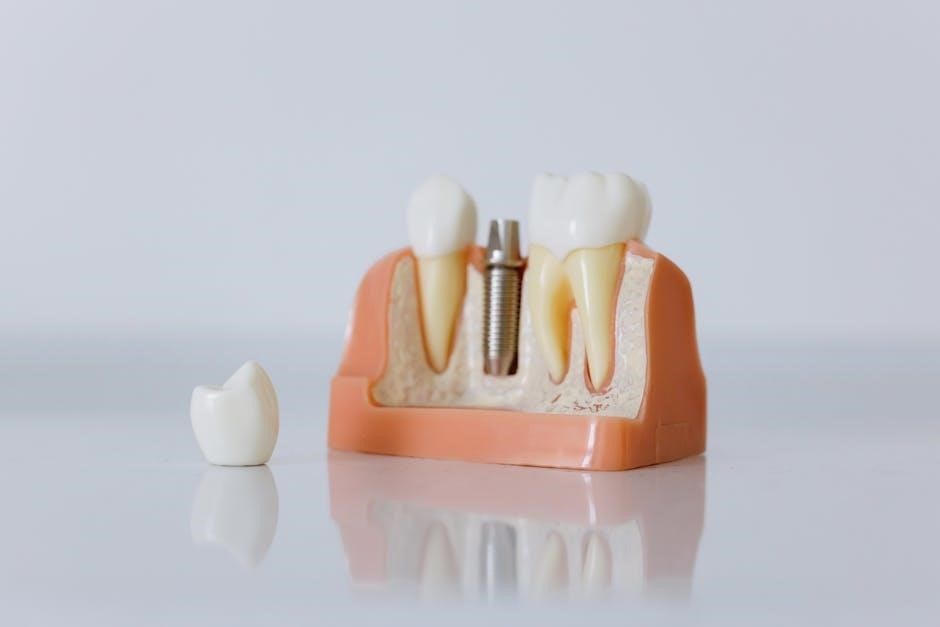



About the author